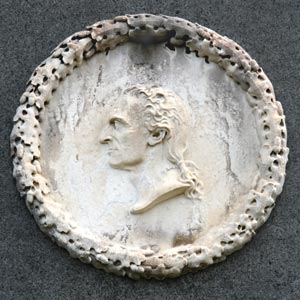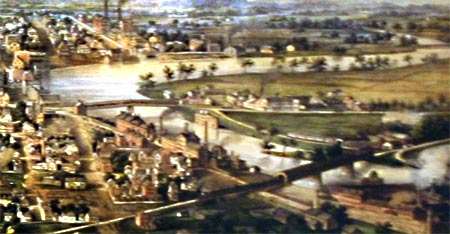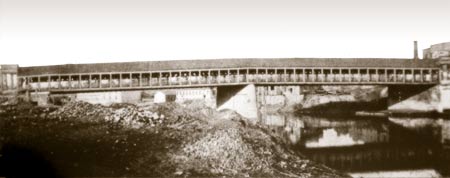
Statue of Lucas Sullivant on the west side of the Scioto River in downtown Columbus at Genoa Park.

Lucas Sullivant
Lucas Sullivant was a surveyor, soldier and explorer who first came to central Ohio in 1795 along with a small group of men who were surveying the land on the west side of the Scioto River which was called the Virginia Military District. Sullivant had no intention of staying in Ohio, only to get the survey job done, get paid and move on to his next assignment.
Sullivant was a young, independent man, who had already proven himself as not only reliable and reliant. The surveying crew of some 20 men that set out from what is now Maysville, Kentucky had already seen conflict with Native Americans living in the Ohio Territory. The only supplies they had, they carried with them. The rest they hunted and scavenged as needed, sometimes going days without food and when they were lucky they ate bear, wild turkey, or deer. But hunting with rifles was risky as any firing of weapons might mean hot food for supper, but also might mean Indians in the area would descend upon them without warning.
When Sullivant arrived in Central Ohio, he fell in love with the land along the Scioto and he set up camp despite the fact that this was extremely dangerous location. At that time, there were no settlers in the area and the only other people where numerous groups of Wyandot and Shawnee Indians. One of the things that attracted Lucas Sullivant, was the rich flat land that would make for good farming.
 Like many surveyors of the time, they often were offered some land in exchange for their services. Sullivant accepted payment for his services by accepting title to the land at the fork of the Scioto and Whetstone Rivers. Even though this land was lower than the higher ground on the east side of the river (that land was not part of the Virginia Military District) and prone to flooding, he felt the area was ideal for establishing the first permanent settlement in Central Ohio.
Like many surveyors of the time, they often were offered some land in exchange for their services. Sullivant accepted payment for his services by accepting title to the land at the fork of the Scioto and Whetstone Rivers. Even though this land was lower than the higher ground on the east side of the river (that land was not part of the Virginia Military District) and prone to flooding, he felt the area was ideal for establishing the first permanent settlement in Central Ohio.
Having been paid several thousand acres for his services, in 1797, he laid out the new town on the western bank of the Scioto River. This included all the land west of the Scioto up to the ridge line that is now called Hilltop, but then it became known as Sullivant's Hill. This town was called Franklinton because of Lucas Sullivant's admiration of Benjamin Franklin who had become a world famous dignitary.
The town lots varied in size, with lots on the outskirts of the town measuring between 100 and 200 hundred acres. Farmland generally sold for between $1 — $2 per acre. But before the first lots could be sold, all of Franklinton washed during a spring flood in 1798. After this first of many floods that would devastate the area in years to come, Sullivant moved the town back from the river and started over laying out the town.

View of Franklin and the Scioto River (looking south) with a covered Broad Street
bridge in the center and the covered railroad bridge in the lower right that leads to
Union Station.
When the State of Ohio decided to build the new capital across the river from Franklinton in 1812, Lucas Sullivant was a bit perturbed. He had already established a thriving little village on the west bank, why couldn't they make Franklinton the capital? There were several reasons. The state's General Assembly had already had in-house political squabbles on where the new capital would be located. First Chillicothe, then Zanesville, then back to Chillicothe. They wanted someplace that didn't have any political ramifications. By selecting the east side of the Scioto, there was no established village and they could build the capital from the ground up. Also, as would be demonstrably proven many times over in the coming years, Franklinton was prone to flooding.

As Columbus was being laid out, Lucas Sullivant and his friend Joseph Foos decided to make the best of the state's plan by first setting up a ferry service that for a fee, would take travelers across the Scioto. Then he built an open toll bridge in 1816 to accommodate more traffic than the slower ferry boat. When the National Road was built through Columbus, the state built a covered bridge to span the river. Since that time there have been 5 more bridges built in the same location. That bridge was located where today you can see the new Broad Street bridge, bridge #7 that was completed in 1992.

Franklinton was annexed to the city of Columbus in 1871. Its boundaries are the Scioto River on the east and north; I-70 on the west; and Greenlawn Avenue on the south.
Lucas Sullivant was originally buried in "Old Franklinton Cemetery" which is still in existence and can be found just east of Souder Avenue and south of Spring Street (south west of the Confluence Restaurant and on the south side of the Scioto River). There is a stone wall surrounding the cemetery plus a bronze plaque. The wall is probably not original to the church.
Sullivant's body was moved from the cemetery and reburied in Greenlawn Cemetery.

Old Franklinton Cemetery
Today not much is left of the Old Franklinton Cemetery other than a few weather-worn headstones and a 26' tall granite obelisk to commemorate the first church established in the area. Lucas Sullivant donated the land and built the church in 1811. The Old Franklinton Cemetery is located on River Street, just off Souder Avenue.
Shortly after the church was completed, the War of 1812 broke out and Franklinton became a recruitment and training center and the church was converted from a place of worship to a grainery. During this time some heavy rains fell and leaked into the church, causing the grain to swell and burst the sides of the church. Recent archeological studies of the area have discovered the foundation of the old church.
In 1824, Lucas Sullivant died of a fever at the age of 58 and was buried in the Old Franklinton Cemetery, but when the newer Green Lawn Cemetery was created in 1848, Sullivant's descendents had his body disinterred and moved to Green Lawn where his marker proudly stands among the 100s of other Columbus dignitaries that made Columbus the city it is today.

Lucas Sullivant, more than just about anyone else, was responsible for establishing the first permanent, truly American settlement in the Ohio Territory at a time when there was nothing but danger surrounding them. His foresight, industrial and resourceful nature made it possible for future generations to thrive and prosper.
Lucas Sullivant the man
There is no doubt that Lucas Sullivant was a brave and enterprising man that used his wits to survive on the frontier. He was a man of force and courage. But he also had a tender side. Before he brought his wife Sarah Starling up from Kentucky, he built the first brick house in the county for her.
When she left Kentucky to be his bride, she also left all the civilities that an established community could offer such as doctors, churches, and most important, family and friends. Besides building her a brick house, he also built the first brick church so she could worship in a building similar to what she left behind. When it came time to deliver her first child, Lucas convinced the best doctor in Chillicothe to come to Franklinton to deliver their new child, and the doctor had to stay with the Sullivant's for 3 weeks until the baby was delivered. The baby girl, died a few years later along with her mother from an epidemic brought on by housing wounded soldiers in their house during the War of 1812.
After Lucas lost his wife and little girl, he carried on with developing his town. Just after he completed building a dam across the Scioto River and building a large grist mill, Lucas Sullivant died at the age of 58, just 26 years after he laid out the first community in Franklin County.
See also:


